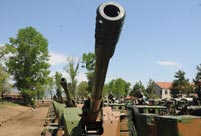

BEIJING, April 7 -- Few individuals savor the sight of the world's busiest railway system more than Wang Wei, a 25-year-old photographer who's travelled thousands of kilometers to photograph China's trains.
"A passing train always sets my heart racing, especially in amazing scenery," said Wang, who, after a decade of photographing trains, considers them his "dearest friend".
He usually spends five months a year braving rough terrain, weather and wildlife in order to capture scenes of trains around China.
So far, he has traveled 200,000 kilometers and snapped around 300,000 photos of all types of trains passing through various landscapes from plateaus and deserts to snowcapped mountains.
He loves the smell of diesel and iron rust. While other people cover their ears to avoid loud train whistles, Wang Wei instead claps.
His photos have earned the budding photographer critical acclaim.
Popular Photograph, China's top-selling photo magazine, named him as one of the best photographers in 2012. Meanwhile, Chinese National Geography, and Lonely Planet have began using his works.
Many attribute his success to his patience and persistence in capturing the perfect photo.
For one photo on the Qinghai-Tibet Plateau, where a section of railway spirals up the mountain at an altitude of 4,000 meters, Wang suffered through 5 nights of altitude sickness waiting for a cloudless sky and a train to pass. His wait was awarded when he captured a train spiraling along the railway with the Big Dipper flashing across the clear sky in the background. He named the photo "Orbit".
"Long-time exploration and persistency award him the best lights and angles," Photo World, a leading Chinese photo magazine, wrote about Wang.
Wang's passion for shooting trains comes from growing up in Beijing next to the Jing-Zhang railway line, China's first, built in 1909.
"I would stand on a little bench, and bend over the window to watch the diesel locomotives for hours," Wang recalled. To his 5-year-old eyes, the machines were an "amazing colossus".
At the age of 11, Wang snapped his first photos of trains after stealing his parents camera and heading down to the tracks without telling them. Later, when his parents developed the film, all the pictures were of trains.
After college, Wang tried to work a regular job at a private media company at the encouragement of his parents, but grew bored after two months and quit. He has dedicated his life to photographing trains since.
"The train itself is very beautiful," Wang says, describing his favorite model the Dongfeng 4, which he watermarks all his photos with.
"It looks dignified, full-figured, moderately angulated, with a strong whistle and rhythm when it starts."
Getting a picture of a Dongfeng 4, a symbol of China's rails and one of the most manufactured model since the 1960s, always excites Wang.
With faster, more modern trains replacing the Dongfeng 4, catching a glimpse of one is a rare treat, he says. Once, after spotting one in a remote mountain area in northwest China's Gansu Province, he raced his car next to it, exclaiming with delight as he kept pace with the steaming beast.
As his photos gain more notoriety, they are also fetching higher prices, allowing him to quit his part-time job as a wedding photographer to dedicate all his time to the hobby.
While once his parents scorned him for quitting his regular job, now they boast about his accomplishments. "My mom praises me to everyone she meets, which makes me blush," he says.
He also got the thumbs up from Wang Fuchun, another well-known Chinese photographer focusing on train travelers, who said Wang Wei's works have successfully preserved the country's rail history.
Throughout 10 years of photographing trains, he has managed to photograph every train developed after 1949, when the People's Republic was founded. He still feels sad when hearing an old model stop circulation. "It's like saying farewell to a family member," he says.
"He did something that the railway authorities should have done," one photography critic said.
Sometimes, he feels helpless that his photos cannot protect these train relics from being abandoned. Once hearing that a water tower near the Jing-Zhang Railway was going to be destroyed, he alerted local media who helped save the tower highlighting its historic value.
In 1949, China only had 21,800 kilometers of railway lines, but now, the number has reached 110,000 km, including 16,000 km of high-speed lines. The length of China's high-speed railway accounts for half of that of the world. Wang doesn't reject faster and easier high-speed train services, but he still likes the old slow trains.
The construction of the new Beijing-Zhangjiakou high-speed railway will start this year and be completed in 2017. It is estimated that the high-speed rail line, stretching 174 kilometers, will shorten the travel time between the two candidate co-host cities for the 2022 Winter Olympics from several hours to 50 minutes.
Wang worries the old railways will be abandoned. Beginning last year, he began fieldwork along the railway, travelling to every bridge and tunnel to collect stories from elder residents nearby. He wants to write a book about the centuries-old railway.
"Most first-hand materials about China's railway history are in the hands of foreigners, that's why people say China is the desert of train culture," said Wang, "I think it is necessary to share what I know to others."
 J-11 fighters in air exercise
J-11 fighters in air exercise Beauties dancing on the rings
Beauties dancing on the rings Attendants-to-be join Mr. & Miss Campus Contest
Attendants-to-be join Mr. & Miss Campus Contest Beijing's toughest anti-smoking law takes effect
Beijing's toughest anti-smoking law takes effect Family lives in cave for about 50 years in SW China
Family lives in cave for about 50 years in SW China PLA soldiers operating vehicle-mounted guns in drill
PLA soldiers operating vehicle-mounted guns in drill Blind carpenter in E China's Jiangxi
Blind carpenter in E China's Jiangxi China hosts overseas disaster relief exercise for the first time
China hosts overseas disaster relief exercise for the first time 20 pairs of twins who will become flight attendants in Sichuan
20 pairs of twins who will become flight attendants in Sichuan Obama is sowing discontent in S.China Sea
Obama is sowing discontent in S.China Sea Rescuers work through night to reach cruise ship survivors
Rescuers work through night to reach cruise ship survivors Driving through limbo
Driving through limbo Facing down MERS
Facing down MERSDay|Week